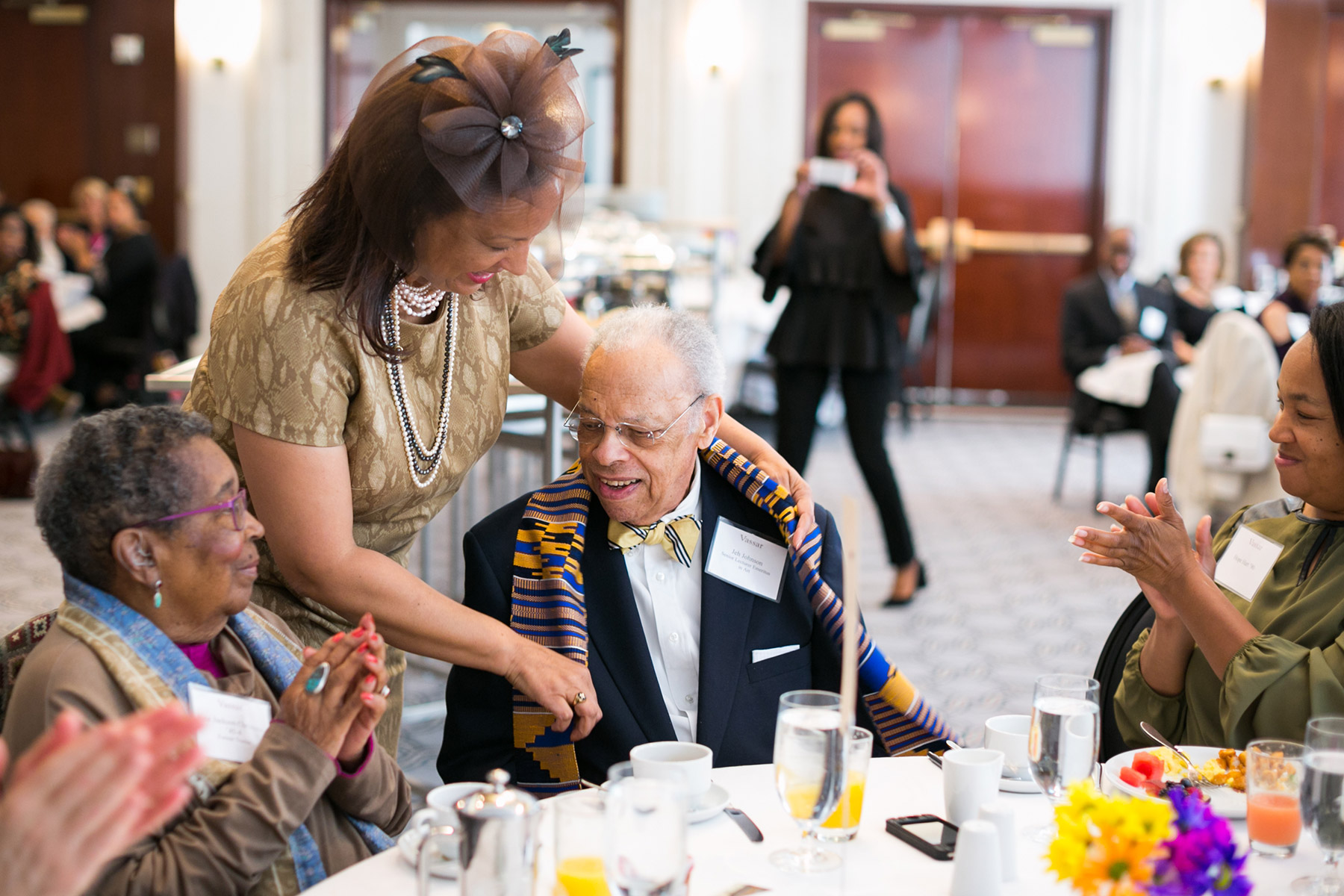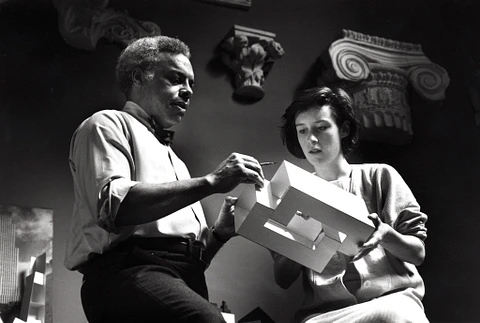Vassar to Rename Cultural Center BuildingNaming to honor the pioneering architect and former faculty member behind its design, Professor Jeh Vincent Johnson
Vassar to Rename Cultural Center BuildingNaming to honor the pioneering architect and former faculty member behind its design, Professor Jeh Vincent Johnson
Vassar College’s ALANA Center, which provides resources and programs for students of color, will be named for Professor Jeh Vincent Johnson, the pioneering African American architect and former Vassar faculty member who designed it. President Elizabeth H. Bradley made the announcement as part of last weekend’s African American Alumnae/i of Vassar College (AAAVC) Triennial, which celebrates the contributions of African American alumnae/i, students, faculty, administrators, and staff of Vassar College. Professor Johnson died in January.

“Throughout his nearly four decades at Vassar, Professor Johnson had enormous impact on our campus, the field of architecture, and even national policy,” Bradley said. “He loved Vassar deeply, and with the renaming of the building as the Jeh Vincent Johnson ALANA Cultural Center, we can demonstrate how deeply Vassar loved him in return.”
Alumnae Paula Madison ’74, Lucey Bowen ’68, and Karen Clopton ’80 have collectively pledged a $125,000, one-to-one matching gift to fund updates and enhancements over the next year, including a newly envisioned entrance, new furniture, and other improvements. A naming ceremony will follow completion of the work in Fall 2022.
The Jeh Vincent Johnson ALANA Cultural Center, which opened in 1993, was one of several buildings on campus that Johnson designed, and will be the first building on Vassar’s campus named for an African American, President Bradley noted.
“There was unanimous support for this initiative from members of the Board of Trustees, who felt that Professor Johnson’s contributions to the creation and building of the Center and his very presence were foundational to the College’s effort to create a more welcoming space for people of color on campus,” said Board Chair Anthony Friscia ’78.
The Jeh Vincent Johnson ALANA Cultural Center is one stop on a tour of historic buildings that is part of Buildings and Belonging: Mapping the African American Experience at Vassar College since 1861, a project that recognizes the contributions of African Americans at Vassar throughout the College’s history with building markers.
Clopton, who envisioned the Buildings and Belonging project said, “Professor Johnson was inspirational, gracious, and most generous with his time, knowledge, and wisdom.”
“We took pride in simply seeing him on campus,” recalled Pat Jordan ’72, who babysat for the Johnson family during her student days. “Renaming the center in his honor will be a perfect, appropriate, and well-deserved tribute.”
Professor Johnson was born in Nashville, TN in 1931. His father, Charles S. Johnson, was President of Fisk University, and his son, Jeh Charles Johnson, was Secretary of Homeland Security Under President Obama from 2013 to 2017.

Professor Johnson came north to attend Columbia University—graduating from both Columbia College and the university’s School of Architecture as class valedictorian. In 1963, he moved to Dutchess County to start an architectural firm with a Columbia classmate and began his part-time teaching position at Vassar shortly after. His course in architectural design was meant to introduce students to the basic skills of the field. “I was a liberal arts student as an undergraduate at Columbia, and I believed that to be an ideal preparation for just about any kind of professional life,” Professor Johnson once said. “But when I entered grad school, I had to learn the fundamentals of drawing and rendering from the start. I was determined to help my students over those catch-up semesters ahead of time.”
Professor Johnson founded the National Organization of Minority Architects—an organization that has opened doors for aspiring architects of color and women. He also took an active role in social issues on the national level. In 1967, President Lyndon Johnson appointed him to serve on the National Commission on Urban Problems. He chaired the National Committee on Housing for the American Institute of Architects (AIA) and was awarded a special citation from the AIA’s New York chapter for his advocacy of equal opportunity in the field, his pioneering work on housing issues, and his commitment to maintaining the cultural integrity and social responsibility of the profession of architecture.
Professor Johnson was beloved by his students, many of whom he shepherded into graduate school and successful architecture careers of their own. Some even attained fellowship in the AIA, the profession’s highest U.S. honor, which Johnson himself had achieved in 1977. These included Sigrid Miller Pollin ’72 and Karen Van Lengen ’73.
“He was the encouraging force that brought me into the field decades ago as an undergraduate art history major,” Pollin recalled. “He offered me my first studio experience. This was pure magic to me.”
“His gentle and generous demeanor coupled with his sonorous voice drew us all into the wonders of his discoveries and his knowledge about architecture and all things related,” said Van Lengen. “He believed that exemplary planning and architecture were agents for social and cultural engagement and the betterment of all in our society.”
President Bradley said that Professor Johnson’s approach was particularly apparent in the design of the center, located in the middle of campus. “In this project, he took what was originally built as a coal bin for the Powerhouse Theatre building and transformed it into a place of community,” she said. “He combined the broad, critical thinking of liberal arts with the practical tools of architecture,” she noted. “In both his teaching and his own architectural work, his contributions were nothing less than transformational.”
The building will itself undergo a transformation of sorts over the next year, Bradley said, with renovations to the entrance, new furniture, and other improvements. A naming ceremony will follow completion of the work in Fall 2022, which will provide an opportunity for the Vassar community to celebrate his life. “When I sent our alumnae/i the note about his death, I was overwhelmed with the number and depth of the responses,” Bradley noted. “Dozens and dozens of his former students responded to my email, wanting to share their experiences with and gratitude for Professor Johnson.”
Professor Johnson’s fanbase extended way beyond students considering architectural careers; many simply appreciated his kindness. “He was truly an exceptional person whose presence in my life made my transition to Vassar, after an African childhood and adolescence, much less daunting,” said Karen Cox ’80. “I know he is gone but until memory fades, I will see that old-school gentleman, walking across campus, a scarf at his neck, at ease in his skin and in the world.”
For more information about the Jeh Vincent Johnson ALANA Cultural Center Matching Gift Challenge, please contact Kristen Andersen at kandersen@vassar.edu.